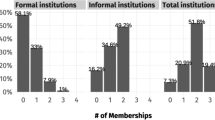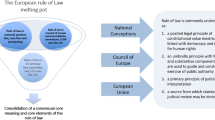Abstract
Since 1959, the European Court of Human Rights (ECHR) can issue judgments against member states of the Council of Europe that violate the European Convention on Human Rights. The number of non-compliance judgments of the Court varies considerably. Some states have been found to violate rules more than 2000 times, while the number of non-compliance judgments is in the single digits for others. Since we know a lot about (non-)compliance in the EU, but not much about the same phenomenon in other regional organizations, this article examines why some countries receive more ECHR judgments than others. Powerful countries, states with limited administrative capacities, and countries without active civil societies tend to have higher shares of ECHR non-compliance judgments. Moreover, the paper argues that under conditions of low legalization, autocratic countries are more likely to block cases from turning into ECHR judgments than countries with higher democracy scores.


Similar content being viewed by others
Notes
Exceptions include Helfer and Slaughter, Brummer, Hafner-Burton, and Jordan, who examine the effectiveness of the European human rights regime and who focus on the impact of and interplay between specific individual rights and the CoE/its member states, respectively (Helfer and Slaughter 1998; Jordan 2003; Brummer 2010; Hafner-Burton 2012), or Voeten who studies the appointment patterns of judges and their judicial independence (Voeten 2007, 2008). Simmons and Cichowski shed light on human rights and study how democratic participation and social mobilization impact states compliance with human rights and its implications for the ECHR (Cichowski 2006; Simmons 2009), while Hillebrecht how states comply with ECHR judgments and how this induces domestic change (Hillebrecht 2014).
For this reason, the European Commission on Human Rights was dissolved in 1998.
This is the longest period of observation for which the data are available under http://hudoc.echr.coe.int/eng (accessed in October 2016). The year 2016 was not included as the data have not been available for the entire year at the point of data collection.
And at the 0.1% level in the time lagged models (Table 4).
References
Abbott, Kenneth W., Robert O. Keohane, Andrew Moravcsik, Anne Marie Slaughter, and Duncan Snidal. 2000. The Concept of Legalization. International Organization 54: 401–419.
Alter, Karen. 2009. The European Court’s Political Power: Selected Essays. Oxford: Oxford University Press.
Börzel, Tanja A. 2001. Non-Compliance in the European Union: Pathology or Statistical Artefact? Journal of European Public Policy 8: 803–824.
Börzel, Tanja A. 2006. Participation Through Law Enforcement. The Case of the European Union. Comparative Political Studies 39: 128–152.
Börzel, Tanja A., and Rachel Cichowski (eds.). 2003. The State of the European Union VI: Law, Politics, and Society. Oxford: Oxford University Press.
Börzel, Tanja A., Tobias Hofmann, Diana Panke, and Carina Sprungk. 2010. Obstinate and Inefficient: Why Member States Do Not Comply with European Law. Comparative Political Studies 43: 1363–1390.
Bradley, Kieran St.Clair. 2002. The European Court of Justice. In The Institutions of the European Union, vol. 1, ed. John Peterson and Michael Shackleton, 118–138. Oxford: Oxford University Press.
Brautigam, Deborah. 1996. State Capacity and Effective Governance. In Agenda for Africa´s Economic Renewal, ed. Nicolas Van de Walle. New Brunswick, NJ: Transaction Press.
Brummer, Klaus. 2010. Enhancing Intergovernmentalism: The Council of Europe and Human Rights. The International Journal of Human Rights 14: 280–299.
Busenberg, George J. 2001. Learning in Organizations and Public Policy. International Public Policy 21: 173–189.
Carrubba, Clifford J., Matthew Gabel, and Charles Hankla. 2008. Judicial behavior under political constraints: Evidence from the European Court of Justice. American Political Science Review 102: 435–452.
Carrubba, Clifford J., and Lacey Murrah. 2005. Legal Integration and the Use of the Preliminary Ruling Process in the European Union. International Organization 59: 399–418.
Chayes, Abram, and Antonia Handler-Chayes. 1991. Compliance Without Enforcement: State Behavior Under Regulatory Treaties. Negotiation Journal 7: 311–330.
Chayes, Abram, and Antonia Handler-Chayes. 1993. On Compliance. International Organization 47: 175–205.
Chayes, Abram, and Antonia Handler-Chayes. 1995. The New Sovereignty. Compliance and International Regulatory Agreements. Cambridge: Harvard University Press.
Checkel, Jeffrey T. 2001. Why Comply? Social Learning and European Identity Change. International Organization 55: 553–588.
Cichowski, Rachel A. 1998. Integrating the Environment: The European Court and the Construction of Supranational Policy. Journal of European Public Policy 5: 387–405.
Cichowski, Rachel A. 2006. Courts, Rights, and Democratic Participation. Comparative Political Studies 39: 50–75.
Cichowski, Rachel A. 2002. Litigation, Mobilization and Governance: The European Court and Transnational Activism. Ph.D. dissertation, University of California.
Conant, Lisa Joy. 2001. Europeanization and the Courts: Variable Patterns of Adaptation among National Judiciaries. In Transforming Europe Europeanization and Domestic Change, ed. Green Cowles Maria, James A. Caporaso, and Thomas Risse, 97–115. Ithaca, NY: Cornell.
Conant, Lisa J. 2002. Justice Contained. Law and Politics in the European Union. Ithaca, NY: Cornell University Press.
Conant, Lisa J. 2006. Individuals, Court, and the Development of European Social Rights. Comparative Political Studies 39: 76–100.
Coyle, Carmel. 1994. Administrative Capacity and the Implementation of EU Environmental Policy in Ireland. In Protecting the Periphery, ed. Susan Baker, Kay Milton, and Steven Yearley, 62–79. Franc Cass: Essex.
Cremona, Marise. 2012. Compliance and the Enforcement of EU Law. Oxford: Oxford University Press.
Downs, George W. 1998. Enforcement and the Evolution of Cooperation. Michigan Journal of International Law 19: 319–344.
Falkner, Gerda, Oliver Treib, Miriam Hartlapp, and Simone Leiber. 2005. Complying with Europe. EU Harmonization and Soft Law in the Member States. Cambridge: Cambridge University Press.
Farkas, Andrew. 1998. State Learning and International Change. Ann Arbor: University of Michigan Press.
Fisher, Roger. 1981. Improving Compliance with International Law. Charlottesville: University of Virginia Press.
Forsythe, David P. 2006. Human Rights in International Relations. Cambridge: Cambridge University Press.
Garrett, Geoffrey, Daniel Kelman, and H. Schulz. 1998. The European Court of Justice: Master or Servant? Legal Politics in the European Union. International Organization 52: 149–170.
Goldstein, Judith, Miles Kahler, Robert O. Keohane, and Anne-Marie Slaughter. 2000. Introduction: Legalization and World Politics. International Organization 54: 385–399.
Hafner-Burton, Emilie M. 2012. International regimes for human rights. Annual Review of Political Science 15: 265–286.
Halrlow, Carol. 1993. Towards a Theory of Access for the European Court of Justice. Yearbook of European Law 213–248.
Hartlapp, Miriam. 2007. On Enforcement, Management and Persuasion: Different Logics of Implementation Policy in the EU and the ILO. Journal of Common Market Studies 45: 653–674.
Helfer, Laurence R., and Anne-Marie Slaughter. 1998. The Effectiveness of the Council of Europe’s Human Rights Regime. In Autonomous Policy Making by International Organizations, ed. Bob Reinalda and B. Verbeek, 141–160. London: Routledge.
Hille, Peter, and Christoph Knill. 2006. ‘It’s the Bureaucracy, Stupid’ The Implementation of the Acquis Communautaire in EU Candidate Countries, 1999–2003. European Union Politics 7: 531–552.
Hillebrecht, Courtney. 2014. The power of human rights tribunals: Compliance with the European Court of Human Rights and domestic policy change. European Journal of International Relations 20: 1100–1123.
Joerges, Christian, and Michael Zürn, eds. 2009. Compliance in Modern Political Systems.
Jordan, Pamela A. 2003. Does membership have its privileges? Entrance into the Council of Europe and compliance with human rights norms. Human Rights Quarterly 25: 660–688.
Kahler, Miles. 2000. Conclusion: The Causes and Consequences of Legalization. International Organization 54: 661–683.
Keller, Helen, and Alec Stone Sweet (eds.). 2008. A Europe of rights: the impact of the ECHR on national legal systems. Oxford: Oxford University Press.
Keohane, Robert O., Andrew Moravcsik, and Anne Marie Slaughter. 2000. Legalized Dispute Resolution: Interstate and Transnational. International Organization 54: 457–488.
Leach, Philip. 2011. Taking a Case to the European Court of Human Rights. Oxford: Oxford University Press.
Levitt, Barbara, and James G. March. 1988. Organizational Learning. Annual Review of Sociology 14: 319–340.
Linos, Katerina. 2007. How Can International Organizations Shape National Welfare States? Evidence from Compliance with European Union Directives. Comparative Political Studies 40: 547–570.
Martin, Lisa L. 1992. Coercive Cooperation: Explaining Multilateral Economic Sanctions. Princeton, NJ: Pinceton University Press.
Mastenbroek, Ellen. 2007. The Politics of Compliance: Explaining the Transposition of EC Directives in the Netherlands. Wageningen: Ponson & Looijen BV.
Mattli, Walter, and Anne-Marie Slaughter. 1998. Revisiting the European Court of Justice. International Organization 52: 177–209.
Mitchell, Ronald. 1994. Regime Design Matters: Intentional Oil Pollution and Treaty Compliance. International Organization 48: 425–458.
Mitchell, Ronald. 1996. Compliance Theory: An Overview. In Improving Compliance with International Environmental Law, ed. J. Cameron, J. Werksman, and P. Roderick. London: Earthscan.
Mitchell, Ronald B., and Patricia M. Keilbach. 2001. Situation Structure and Institutional Design: Reciprocity, Coercion, and Exchange. International Organization 55: 891–917.
Panke, Diana. 2007. The European Court of Justice as an Agent of Europeanization? Restoring Compliance with EU Law. Journal of European Public Policy 14: 847–866.
Panke, Diana. 2010a. The Effectiveness of the European Court of Justice. Why Reluctant States Comply. Manchester: Manchester University Press.
Panke, Diana. 2010b. Why Big States Cannot Do What They Want. International Courts and Compliance. International Politics 47: 186–209.
Perkins, Richard, and Eric Neumayer. 2007. “Do Membership Benefits Buy Regulatory Compliance? European Union Politics 8: 180–206.
Ponce-Nava, Diana. 1995. Capacity Building in Environmental Law and Sustainable Development. In Sustainable Development and International Law, ed. Winfried Lang, 131–136. Boston: Graham & Trotman.
Rasmussen, Hjalte. 1986. On Law and Policy in the European Court of Justice. A Comparative Study in Judicial Policymaking. Dordrecht: Martinus Nijhoff Publishers.
Schmitz, Hans-Peter, and Kathryn Sikkink. 2002. International Human Rights. In Handbook of International Relations, ed. Walter Carlsnaes, Thomas Risse, and Beth A. Simmons, 517–537. London: Sage.
Schoppa, Leonard J. 1999. The Social Context in Coercive International Bargaining. International Organization 53: 307–342.
Simmons, Beth A. 2009. Mobilizing for human rights: international law in domestic politics. Cambridge: Cambridge University Press.
Simmons, Beth, and Ashley DiSilvestro. 2014. Human Trafficking. The European Union Commitment to Fight Human Trafficking. In The European Union with(in) International Organisations. Commitment, Consistency and Effects across Time, ed. Amandine Orsini, Globalisation, Europe, Multilateralism, 137–155. Farnham/Burlington: Ashgate.
Stone Sweet, Alec. 2000. Governing with Judges: Constitutional Politics in Europe. Oxford: Oxford University Press.
Stone Sweet, Alec, and Thomas L. Brunell. 1997. The European Court and National Courts: A Statistical Analysis of Preliminary References, 1961–1995. Jean Monnet Working Paper Series 97.
Tallberg, Jonas. 2000. Supranational Influence in EU Enforcement: The ECJ and the Principle of State Liability. Journal of European Public Policy 7: 104–121.
Tallberg, Jonas. 2002. Paths to Compliance: Enforcement, Management, and the European Union. International Organization 56: 609–643.
Tallberg, Jonas, and J. Christer. 1998. Compliance and Post-Agreement Bargaining. European Journal of International Relations 4: 371–408.
Toshkov, Dimiter. 2008. Embracing European Law Compliance with EU Directives in Central and Eastern Europe. European Union Politics 9: 379–402.
Treib, Oliver. 2014. Implementing and Complying with EU Governance Outputs. Living Reviews of European Governance 9: 1. http://www.europeangovernance-livingreviews.org/Articles/lreg-2014-1/.
Underdal, Arild. 1998. Explaining Compliance and Defection: Three Models. European Journal of International Relations 4: 5–30.
Verdirame, Guglielmo. 2011. The UN and Human Rights Who Guards the Guardians?. Cambridge: Cambridge University Press.
Voeten, Erik. 2007. The Politics of International Judicial Appointments: Evidence from the European Court of Human Rights. International Organization 61: 669–701.
Voeten, Eric. 2008. The Impartiality of International Judges: Evidence from the European Court of Human Rights. American Political Science Review 102: 417–433.
Weiler, Joseph H.H. 1994. A Quiet Revolution—The European Court of Justice and its Interlocutors. Comparative Political Studies 26: 510–534.
Zürn, Michael, and Christian Joerges. eds. 2005. Law and Governance in Postnational Europe: Compliance Beyond the Nation-State. Cambridge: Cambridge University Press.
Author information
Authors and Affiliations
Corresponding author
Additional information
Publisher's Note
Springer Nature remains neutral with regard to jurisdictional claims in published maps and institutional affiliations.
Rights and permissions
About this article
Cite this article
Panke, D. The European Court of Human Rights under scrutiny: explaining variation in non-compliance judgments. Comp Eur Polit 18, 151–170 (2020). https://doi.org/10.1057/s41295-019-00157-6
Published:
Issue Date:
DOI: https://doi.org/10.1057/s41295-019-00157-6




